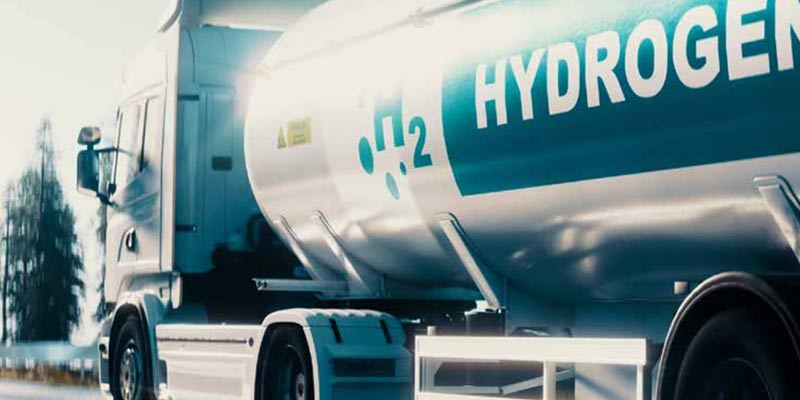- India
- Mar 05
- Sreesha V.M
Tata Motors begins trials of hydrogen-powered trucks
• Union Minister Nitin Gadkari and Pralhad Joshi flagged off the first-ever trials of hydrogen-powered heavy-duty trucks launched by Tata Motors in New Delhi on March 4.
• The trial marks a significant step towards sustainable long-distance cargo transportation in the country.
• Tata Motors was awarded the tender for this trial, which is funded by the Ministry of New and Renewable Energy under the National Green Hydrogen Mission.
• It marks a significant step forward in assessing the real-world commercial viability of using hydrogen powered vehicles for long distance haulage as well as setting-up the requisite enabling infrastructure for their seamless operation.
• The trial phase will span up to two years and involves deployment of 16 advanced hydrogen-powered vehicles with varying configurations and payload capacities.
• These trucks, equipped with new age Hydrogen Internal Combustion Engines (H2-ICE) and Fuel Cell (H2-FCEV) technologies, will be tested on India’s most prominent freight routes, including those around Mumbai, Pune, Delhi-NCR, Surat, Vadodara, Jamshedpur and Kalinganagar.
• The first batch of three hydrogen-powered heavy-duty trucks will operate on the Faridabad-Delhi NCR and Ahmedabad-Surat-Vadodara routes.
• To support this transition, Indian Oil Corporation Limited (IOCL) is establishing hydrogen refueling stations in Faridabad, Vadodara, Pune, and Balasore.
What is green hydrogen?
• Although hydrogen is the lightest and most abundant element in the universe, it is rarely found in nature in its elemental form and always must be extracted from other hydrogen-containing compounds. It also means that how well hydrogen contributes to decarbonisation depends on how clean and green the method of production is.
Based on the sources and processes, hydrogen can be classified into various colours:
i) Black/Brown/Grey hydrogen is produced by coal or lignite gasification (black or brown), or via a process called steam methane reformation (SMR) of natural gas or methane (grey). These tend to be mostly carbon-intensive processes.
ii) Blue hydrogen is produced by natural gas or coal gasification combined with carbon capture storage (CCS) or carbon capture use (CCU) technologies to reduce carbon emissions.
iii) Green hydrogen is produced using electrolysis of water with electricity generated by renewable energy. The carbon intensity ultimately depends on the carbon neutrality of the source of electricity. Which means, the more renewable energy there is in the electricity fuel mix, the “greener” the hydrogen produced.
National Green Hydrogen Mission
• In January 2023, Prime Minister Narendra Modi-led Cabinet approved the National Green Hydrogen Mission with an outlay of Rs 19,744 crore.
• The Mission is expected to attract Rs 8 lakh crore of investment in the green hydrogen chain.
• India aims to produce 5 million tonnes of green hydrogen per annum in the next five years and the incentives would help bring down the cost.
Significance of this Mission
• India has a unique opportunity to become a global leader in the hydrogen energy ecosystem. With proper policy support, industry action, market generation and acceptance, and increased investor interest, India can position itself as a low-cost, zero-carbon manufacturing hub, at the same time fulfilling its goal of economic development, job creation, and improved public health.
• The current impetus surrounding the hydrogen transition fits well within the context of a low-carbon economy, energy security, and the larger economic development ambition of the nation.
• Hydrogen demand in India could grow more than four-fold by 2050, representing almost 10 per cent of global hydrogen demand. Initial demand growth is expected from mature markets like refinery, ammonia, and methanol, which are already using hydrogen as industrial feedstock and in chemical processes.
• The cumulative value of the green hydrogen market in India could be $8 billion by 2030 and $340 billion by 2050.
The Mission will have wide ranging benefits:
i) Creation of export opportunities for green hydrogen and its derivatives.
ii) Decarbonisation of industrial, mobility and energy sectors.
iii) Reduction in dependence on imported fossil fuels and feedstock.
iv) Development of indigenous manufacturing capabilities.
v) Creation of employment opportunities.
vi) Development of cutting-edge technologies.
• The Mission will facilitate demand creation, production, utilisation and export of green hydrogen.
• Under the Strategic Interventions for Green Hydrogen Transition Programme (SIGHT), two distinct financial incentive mechanisms — targeting domestic manufacturing of electrolysers and production of green hydrogen — will be provided under the Mission.
• The Mission will also support pilot projects in emerging end-use sectors and production pathways.
• Regions capable of supporting large scale production and/or utilisation of hydrogen will be identified and developed as Green Hydrogen Hubs.
• An enabling policy framework will be developed to support establishment of the green hydrogen ecosystem. A robust standards and regulations framework will be also developed.
• A public-private partnership framework for R&D (Strategic Hydrogen Innovation Partnership — SHIP) will be facilitated under the Mission.
• R&D projects will be goal-oriented, time bound, and suitably scaled up to develop globally competitive technologies. A coordinated skill development programme will also be undertaken.
• All concerned ministries, departments, agencies and institutions of the central and state governments will undertake focussed and coordinated steps to ensure successful achievement of the Mission objectives.
(The author is a trainer for Civil Services aspirants.)


